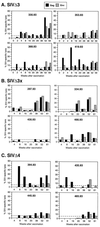Highly attenuated vaccine strains of simian immunodeficiency virus protect against vaginal challenge: inverse relationship of degree of protection with level of attenuation
- PMID: 10233957
- PMCID: PMC112539
- DOI: 10.1128/JVI.73.6.4952-4961.1999
Highly attenuated vaccine strains of simian immunodeficiency virus protect against vaginal challenge: inverse relationship of degree of protection with level of attenuation
Abstract
Three different deletion mutants of simian immunodeficiency virus (SIV) that vary in their levels of attenuation were tested for the ability to protect against mucosal challenge with pathogenic SIV. Four female rhesus monkeys were vaccinated by intravenous inoculation with SIVmac239Delta3, four with SIVmac239Delta3X, and four with SIVmac239Delta4. These three vaccine strains exhibit increasing levels of attenuation: Delta3 < Delta3X <Delta4. The vaccinated monkeys were challenged by vaginal exposure to uncloned, pathogenic SIVmac251 at 61 weeks after the time of vaccination. On the basis of viral RNA loads in plasma, cell-associated virus loads in peripheral blood, and CD4 cell counts, strong protective effects were observed in all three groups of vaccinated monkeys. However, the degree of protection correlated inversely with the level of attenuation; the least-attenuated strain, SIVmac239Delta3, gave the greatest protection. One monkey in the Delta3X group and two in the Delta4 group clearly became superinfected by the challenge virus, but these animals had levels of SIV RNA in plasma that were considerably lower than those of naive animals that were challenged in parallel. Protection against vaginal challenge appears easier to achieve than protection against intravenous challenge, since four other SIVmac239Delta4-vaccinated monkeys showed no protection when challenged intravenously with a much lower inoculum of the same challenge virus stock. Protection against vaginal challenge in the Delta4-vaccinated group occurred in the absence of detectable serum neutralizing activities and appeared to be associated with the development of an early SIV-specific cytotoxic-T-lymphocyte response. Our results demonstrate that mucosal protection can be achieved by systemic immunization with the highly attenuated SIVmac239Delta4 more than 1 year prior to the time of challenge.
Figures









References
-
- Almond N, Kent K, Cranage M, Rud E, Clarke B, Stott E J. Protection by attenuated simian immunodeficiency virus in macaques against challenge with virus-infected cells. Lancet. 1995;345:1342–1344. - PubMed
-
- Benson J, Chougnet C, Robert-Guroff M, Montefiori D, Markham P, Shearer G, Gallo R C, Cranage M, Paoletti E, Limbach K, Venzon D, Tartaglia J, Franchini G. Recombinant vaccine-induced protection against the highly pathogenic simian immunodeficiency virus SIV(mac251): dependence on route of challenge exposure. J Virol. 1998;72:4170–4182. - PMC - PubMed
-
- Cole K S, Rowles J L, Jagerski B A, Murphy-Corb M, Unangst T, Clements J E, Robinson J, Wyand M S, Desrosiers R C, Montelaro R C. Evolution of envelope-specific antibody responses in monkeys experimentally infected or immunized with simian immunodeficiency virus and its association with the development of protective immunity. J Virol. 1997;71:5069–5079. - PMC - PubMed
-
- Connor R I, Montefiori D C, Binley J M, Moore J P, Bonhoeffer S, Gettie A, Fenamore E A, Sheridan K E, Ho D D, Dailey P J, Marx P A. Temporal analyses of virus replication, immune responses, and efficacy in rhesus macaques immunized with a live, attenuated simian immunodeficiency virus vaccine. J Virol. 1998;72:7501–7509. - PMC - PubMed
-
- Cranage M P, Whatmore A M, Sharpe S A, Cook N, Polyanskaya N, Leech S, Smith J D, Rud E W, Dennis M J, Hall G A. Macaques infected with live attenuated SIVmac are protected against super-infection via the rectal mucosa. Virology. 1997;229:143–154. - PubMed
Publication types
MeSH terms
Substances
Grants and funding
LinkOut - more resources
Full Text Sources
Other Literature Sources
Research Materials

